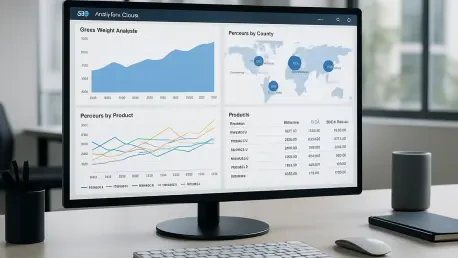Imagine a future where businesses can foresee customer desires, predict market fluctuations, and avert potential disasters before they even emerge, all thanks to the power of intelligent systems that think and adapt like humans. This is the transformative potential of cognitive analytics, an innovative domain that harnesses artificial intelligence (AI), machine learning (ML), and natural language processing (NLP) to replicate human cognitive processes. By analyzing vast datasets—both structured and unstructured—these systems provide real-time insights and predictive solutions, fundamentally changing how industries operate. Unlike traditional analytics, cognitive tools learn from experience, offering a dynamic approach to decision-making that is becoming essential in a data-driven world. The global market for cognitive analytics, valued at USD 3.9 billion in 2023, is projected to skyrocket to USD 44.92 billion by 2032, reflecting a compound annual growth rate (CAGR) of 31.2% from the current year onward. This staggering growth signals a paradigm shift, positioning cognitive analytics as a cornerstone for industries ranging from healthcare to finance, retail to manufacturing. As companies race to adopt these technologies, the question arises: how will this revolution reshape the industrial landscape over the next several years? The answer lies in exploring the profound impacts, technological drivers, and regional dynamics that are fueling this unprecedented change.
Redefining Industry Standards with Cognitive Analytics
Cognitive analytics stands as a revolutionary force, poised to redefine operational standards across a wide array of sectors. Far beyond a fleeting technological trend, it represents a fundamental shift in how businesses handle data, offering the ability to process complex information like text, images, and social media interactions with unmatched precision. This capability allows organizations to extract actionable insights from previously untapped sources, transforming raw data into strategic advantages. In healthcare, for instance, cognitive systems empower predictive diagnostics, enabling medical professionals to anticipate patient complications and design personalized treatment plans with remarkable accuracy. This not only improves patient outcomes but also optimizes resource allocation within hospitals. Meanwhile, the financial sector benefits immensely through enhanced fraud detection and risk management, as these systems identify suspicious patterns in real-time, safeguarding transactions and minimizing losses. The implications are profound, as industries increasingly rely on such tools to navigate the complexities of a data-centric environment, ensuring they remain agile and competitive in an ever-evolving market landscape.
Beyond healthcare and finance, cognitive analytics is making significant inroads into retail and manufacturing, tailoring solutions to meet specific industry needs. Retailers harness these tools to gain deep customer insights, analyzing purchasing behaviors and social trends to craft personalized shopping experiences that boost brand loyalty. This data-driven approach ensures that marketing efforts are not only relevant but also highly effective. In manufacturing, the focus shifts to operational efficiency, with predictive maintenance playing a pivotal role in optimizing supply chains. By foreseeing equipment failures before they occur, factories can minimize downtime and reduce costs, maintaining seamless production cycles. The versatility of cognitive analytics lies in its adaptability, offering customized solutions that address the unique challenges of each sector. As industries continue to integrate these technologies, the potential for innovation grows exponentially, setting new benchmarks for efficiency and customer engagement that were once unimaginable. This widespread adoption underscores the necessity of cognitive analytics as a strategic imperative for future growth.
Technological Foundations Fueling the Revolution
At the core of cognitive analytics lies artificial intelligence, a driving force that empowers systems to detect hidden patterns, forecast trends, and refine their capabilities over time through continuous learning. Components such as machine learning and deep learning enable these platforms to evolve without explicit programming, ensuring that insights become increasingly accurate with each interaction. Natural language processing further enhances functionality by allowing systems to comprehend human language, facilitating applications like sentiment analysis and personalized recommendations. This means that customer service tools, such as chatbots, can now engage in meaningful conversations, addressing queries with a level of understanding that mirrors human interaction. The seamless integration of these AI elements into cognitive analytics platforms is transforming how businesses process information, making complex data analysis not just possible but also highly efficient across diverse applications.
Technological advancements are rapidly accelerating the adoption of cognitive analytics, with innovations like in-memory computing and sophisticated algorithms slashing processing times and enhancing precision. Businesses can now manage enormous datasets without the delays that once hindered decision-making. Additionally, visualization tools such as interactive dashboards democratize data access, enabling employees at all levels to extract valuable insights without requiring advanced technical expertise. A notable example of this progress is seen in recent developments like Snowflake’s integration of large language models into its cloud data platform in 2024, which has made conversational AI a practical tool for enterprise data analysis. Such breakthroughs illustrate how technology is making cognitive analytics more intuitive and accessible, ensuring that organizations of varying sizes can leverage these powerful systems to drive informed decisions and maintain a competitive edge in their respective fields.
Market Dynamics and Leading Solutions
The cognitive analytics market is characterized by diverse deployment models, including on-premises, cloud-based, and hybrid solutions, with the cloud segment emerging as the dominant force due to its scalability and cost-effectiveness. These platforms provide real-time data processing and elastic storage, aligning perfectly with the needs of modern enterprises undergoing digital transformation. The flexibility of cloud solutions supports remote workforces and global teams, ensuring that businesses can access critical insights anytime, anywhere. This adaptability has made cloud-based cognitive analytics a preferred choice for organizations looking to streamline operations without the burden of extensive infrastructure investments. As digital ecosystems expand, the reliance on cloud technology is expected to grow, further solidifying its position as a cornerstone of the market.
While cloud solutions lead, hybrid models are experiencing the fastest growth, offering a balanced approach that combines the security of on-premises systems for sensitive data with the computational power of the cloud for intensive analytics tasks. This dual structure addresses critical concerns around data privacy and regulatory compliance, making it an attractive option for industries with stringent requirements. Among applications, customer insights stand out as the most significant segment, as businesses prioritize understanding consumer behavior to deliver tailored experiences in sectors like retail and telecommunications. Meanwhile, fraud detection is rapidly gaining traction as the fastest-growing application, driven by the surge in digital transactions and escalating cybersecurity threats. Cognitive analytics enables real-time anomaly detection, providing financial institutions and e-commerce platforms with robust tools to mitigate risks effectively, highlighting the market’s responsiveness to pressing global challenges.
Sector-Specific Impacts and Adoption Trends
Certain industries are at the forefront of adopting cognitive analytics, with healthcare and banking leading the charge due to their high-stakes environments and critical data needs. In healthcare, these systems optimize patient care by predicting health risks and tailoring treatments, ultimately saving lives through data-driven precision. Banking, on the other hand, relies heavily on cognitive tools for fraud prevention and risk assessment, ensuring the security of financial transactions in an increasingly digital world. The ability to analyze vast amounts of data in real-time allows these sectors to respond swiftly to emerging issues, setting a standard for how technology can enhance both safety and efficiency. As regulatory landscapes evolve, cognitive analytics continues to adapt, offering solutions that meet compliance demands while delivering measurable outcomes.
Retail and manufacturing sectors are also embracing cognitive analytics, focusing on distinct yet equally impactful applications. Retailers leverage these tools to deepen customer engagement, using insights from purchasing patterns and social media trends to craft marketing strategies that resonate on a personal level. This targeted approach not only boosts sales but also fosters long-term loyalty. In manufacturing, the emphasis is on operational excellence, with predictive maintenance reducing equipment failures and cutting downtime costs significantly. These industry-specific applications demonstrate the versatility of cognitive analytics, as tailored platforms address unique challenges while driving innovation. The growing adoption across these diverse fields signals a broader trend: cognitive analytics is becoming indispensable for organizations aiming to navigate complex market dynamics and achieve sustainable growth in a competitive landscape.
Global Reach and Regional Growth Patterns
The cognitive analytics market exhibits distinct regional dynamics, with North America holding a commanding share due to its advanced technological infrastructure and strong demand for data-driven solutions. The United States spearheads this dominance, supported by major technology companies and substantial investments in research and development, particularly in industries like healthcare and finance. However, Canada is emerging as the fastest-growing market within the region, propelled by initiatives in healthcare digitization and government policies that promote predictive analytics. This growth in smaller markets highlights the untapped potential that exists beyond traditional tech hubs, suggesting that widespread adoption could further accelerate as awareness and infrastructure improve over the coming years.
Asia Pacific represents another vital growth engine, driven by rapid digital transformation and significant investments in intelligent business solutions. Japan stands out with its established technological ecosystem, particularly in finance and healthcare, where cognitive analytics is already deeply integrated. South Korea, meanwhile, is the fastest-growing market in the region, fueled by government-backed initiatives, smart city projects, and advancements in 5G infrastructure that enhance analytics capabilities. Europe, balancing innovation with strict regulatory frameworks like the General Data Protection Regulation (GDPR), sees strong contributions from Germany, France, and the United Kingdom. Germany’s manufacturing sector drives digitalization, while France focuses on finance and public services, and the UK leverages its tech-savvy ecosystem for customer engagement. These regional variations underscore how cultural, economic, and policy differences shape the global trajectory of cognitive analytics adoption.
Navigating Challenges in a Data-Driven Future
Despite the immense promise of cognitive analytics, significant challenges remain that could impede its widespread adoption if not addressed. Data privacy and security stand as primary concerns, especially since these systems often handle sensitive information, making them potential targets for breaches and misuse. Strict regulations, such as GDPR in Europe, impose limitations on data usage, particularly in sectors like healthcare where compliance is non-negotiable. These constraints can slow the deployment of cognitive analytics in regions with heavy regulatory oversight, creating a complex landscape for global businesses to navigate. As data becomes increasingly central to operations, ensuring robust protection mechanisms will be critical to maintaining trust and fostering continued growth in this field.
Another substantial barrier is the high cost associated with implementing and maintaining cognitive analytics systems, which can be particularly prohibitive for small and medium-sized enterprises (SMEs). The upfront investments in infrastructure, software, and skilled personnel, combined with ongoing maintenance expenses, often deter smaller players from entering the market. However, the rise of cost-effective cloud solutions is beginning to bridge this gap, offering accessible alternatives that reduce financial burdens. As technology continues to evolve, further innovations are expected to lower entry barriers, enabling a broader range of organizations to harness the power of cognitive analytics. Addressing these challenges through strategic partnerships and scalable solutions will be essential to ensuring that the benefits of this technology are realized across all business sizes and sectors.
Envisioning a Transformed Industrial Horizon
Reflecting on the journey of cognitive analytics, it’s evident that the groundwork laid in recent years has already begun to reshape industries by integrating advanced data analysis into everyday operations. By the close of the previous decade, the market had demonstrated its potential to redefine decision-making processes, as businesses across healthcare, finance, retail, and manufacturing adopted these tools to enhance efficiency and foresight. The exponential growth trajectory, which saw the market poised to reach USD 44.92 billion by 2032, was a testament to the foundational innovations in AI and machine learning that had been embraced widely. Looking back, the challenges of data privacy and high costs were met with incremental solutions, such as cloud-based platforms, that had started to democratize access to this transformative technology.
As industries move forward from this pivotal era, the focus should shift toward actionable strategies that build on past achievements. Strengthening data security frameworks will be paramount to address lingering concerns, ensuring compliance with evolving regulations while fostering trust. Additionally, investment in education and training programs can equip workforces with the skills needed to leverage cognitive analytics effectively, particularly in smaller enterprises. Collaboration between technology providers and industry leaders should aim to develop affordable, scalable solutions that cater to diverse needs. By prioritizing these steps, the industrial landscape can fully realize the potential of cognitive analytics, turning the vision of predictive, intelligent systems into a sustainable reality that drives innovation and competitiveness across the globe.









